Table of Contents
ToggleMANAGEMENT STYLES
Management styles in nursing refer to the different approaches and strategies that nurse leaders use to manage their teams and achieve organizational goals.
These styles can have a significant impact on job satisfaction, nurse retention rates, quality of care, and patient outcomes.
Management styles in health practice and within health care institutions include the 3D’s, i.e Directing, Discussing and Delegating.
- Directing Style:
Managers tell people what to do, how to do it and when to have it completed. They assign roles and responsibilities, set standards and define expectations. The people who use this style are called Autocratic (or authoritarian) managers i.e. they make all the important decisions and closely supervise and control workers. Managers do not trust workers and simply give orders (one-way communication) that they expect to be obeyed. This approach derives from the views of Taylor as to how to motivate workers and relates to McGregor’s theory X view of workers.
- Discussing Style:
Managers who adopt this style take the time to discuss pertinent business issues. They encourage individuals to present their ideas, ask questions, actively listen, provide feedback, challenge assumptions, and offer guidance when necessary. Ensuring that ideas are thoroughly discussed and debated is considered essential. In this style, managers often assume the role of facilitator, ensuring that the discussion remains focused and that everyone has an opportunity to contribute. This management style is commonly referred to as paternalistic management.
- Delegating Style:
Managers using this style usually explain or get agreement on what has to be accomplished and when it must be completed. The how-to-do-it part of the equation is left up to the employee. Responsibility and authority are given to employees to get the job done.
MANAGEMENT THEORIES
Understanding management theories is important for developing effective management styles, especially in roles like building up nurse leaders. There are four key theories focused on management, particularly for nurse managers:
1.Classical organization theory
- Bureaucracy management theory
- Scientific management theory
- Administrative Management theory
2. Contingency theory.
3. Human relation theory.
4. Behavioral science theory.
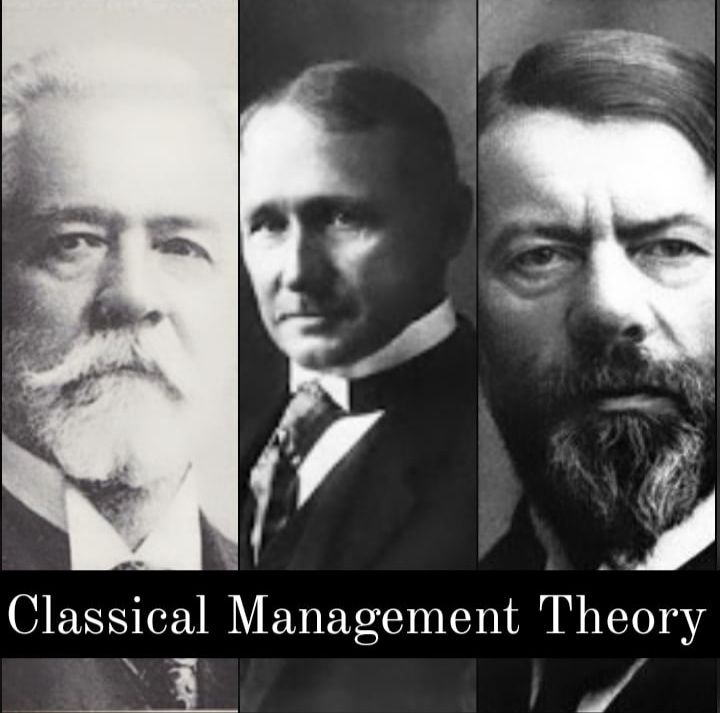
CLASSICAL ORGANIZATION THEORY
During the 19th century, there was a significant shift in societies from agricultural and non-mechanized practices to commercial and industrial ones, due to the industrial revolution. This led to the establishment of new manufacturing processes, increased industrialization, and the emergence of large groups of people working together. People began working alongside machinery, and companies sought more efficient ways to address the new challenges and enhance productivity. As a result, there was a growing interest in organizing people effectively and managing resources in a manner that would maximize profits.
As a reaction to all of these changes taking part in the world back then, the classical management theory emerged.
Max Weber, Frederick Taylor and Henri Fayol – are considered as the founding fathers of classical management theory. They tried to answer the questions generated by the industrial revolution, concerning the organizational and managerial side, each one from his own vision .
The German sociologist Max Weber (1864-1920) is mostly known for the term Bureaucracy. According to this thesis, Max Weber’s theory of bureaucracy is a management approach that proposes a specific way to organize and run an organization. It emphasizes the importance of a rigid hierarchical structure, strict rules and regulations, and standardized processes. Weber believed that bureaucracy was the most efficient and effective way to manage large organizations and achieve maximum productivity.
The American mechanical engineer Frederick Taylor (1856-1915) promoted another approach called “scientific management” that was against customized self-styled work; he saw this as an obstacle to increasing productivity. Instead, he called for “applying science to work ” by studying every task and finding out how much time and motion it takes to be done and then come up with one standardized right way to perform every task.
The French mining engineer Henri Fayol (1841-1923) in his book ” General And Industrial Management ” developed an Administrative Management approach which argued that there are some managerial activities that every manager should be good at. These activities include: planning, organizing, commanding, coordination, and control. To master these skills he wanted managers to be trained in a more systematic approach .
PRINCIPLES OF CLASSICAL ORGANIZATION THEORY
In addition to all of the above, Weber, Taylor and Fayol all agreed about some common ideas. These ideas constituted the main principles of the classical management theory:
- Clearly Defined Hierarchy: The organization should have a well-defined chain of command and authority, with clear levels of management and supervision.
- Division of Labor: Tasks and responsibilities should be divided among employees based on their skills and expertise, allowing for specialization and increased efficiency.
- Standardized Approach to Work: Work processes and procedures should be standardized to ensure consistency and quality in performance.
- Formalization and Separation between Personal and Work Life: There should be a clear distinction between personal life and work life, with formal rules and regulations governing behavior and interactions within the organization.
- Selection of the Best Employees: The organization should strive to hire the most qualified individuals for each job, ensuring higher performance and effectiveness.
- Fair Compensation: Employees should be paid fairly for their work, based on their skills, responsibilities, and contributions to the organization.
The ideas of Max Weber, Frederick Taylor and Henri Fayol all came together to form a foundation of what’s called today classical management theory which is actually considered as the basis of all the other managerial theories that came later.
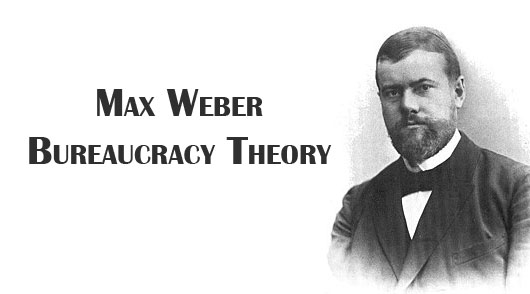
THEORY OF BUREAUCRACY(Max Weber’s)
Max Weber’s theory of bureaucracy is a management approach that proposes a specific way to organize and run an organization. It emphasizes the importance of a rigid hierarchical structure, strict rules and regulations, and standardized processes. Weber believed that bureaucracy was the most efficient and effective way to manage large organizations and achieve maximum productivity.
Key principles of Max Weber’s theory of bureaucracy
- Hierarchy: The organization is structured into a clear hierarchy of authority, with each level having specific responsibilities and reporting to the level above it.
- Division of Labor: Tasks and responsibilities are divided among employees based on their specialized skills and competencies. This specialization allows for increased efficiency and effectiveness.
- Formal Selection: Employees are selected based on their technical qualifications and skills, which are acquired through training, education, and experience. Formal selection ensures that employees are well-suited for their roles.
- Rules and Regulations: Bureaucratic organizations rely on a set of formal rules and regulations that govern behavior, decision-making, and processes. These rules provide clarity and consistency in how work is performed.
- Impersonality: Interactions within a bureaucratic organization are based on formal rules and procedures rather than personal relationships. This helps to prevent favoritism and ensures fairness.
- Career Orientation: Bureaucratic organizations provide opportunities for employees to advance their careers based on their expertise and experience. This allows for the optimal utilization of human capital.

SCIENTIFIC MANAGEMENT THEORY(Taylor)
Around a century ago, Frederick Taylor argued for enhanced efficiency in jobs through thorough analysis. With well-designed tasks and adequate incentives, workers could achieve higher productivity. For example, Taylor advocated for paying based on output rather than hours worked, creating incentives for efficient work. In health care, the equivalent would be by the number of patients bathed or visited at home rather than by the number of hours worked. This would create an incentive to get the most work done in the least amount of time.
- Frederick Taylor’s scientific management theory, also known as the classical management theory, focuses on improving efficiency and productivity in the workplace.
- Taylor believed that jobs should be simplified and optimized to increase productivity. He emphasized the importance of managers interacting with their subordinates to enhance efficiency.
- His theory is based on four principles: the scientific approach to work, scientific selection and training of employees, collaboration between employees and employers, and the division of work and responsibilities among employees.
- Taylor’s approach has gained traction in today’s business climate, where there is a focus on work-life balance and employee satisfaction.
Principles of Scientific Management by Frederick Taylor
Frederick Taylor’s Principles of Scientific Management, also known as Taylorism, are a set of principles aimed at improving efficiency and productivity in industrial workplaces. These principles focus on the division of labor, scientific selection and training of workers, cooperation between management and workers, and the development of standardized procedures.
- Develop a science for each element of work: Taylor believed that every task should be analyzed and broken down into its individual components. By studying each element scientifically, optimal methods and procedures can be developed to maximize efficiency and productivity.
- Scientifically select, train, teach, and develop the worker: According to Taylor, workers should be carefully selected based on their abilities and suitability for a particular task. They should then be trained and educated in the most efficient methods of performing their work. Continuous development and improvement of workers’ skills are essential for achieving maximum productivity.
- Cooperate with the worker: Taylor emphasized the importance of cooperation between management and workers. Managers should provide guidance, support, and assistance to workers, ensuring that the work is done in accordance with the established scientific principles. This cooperation helps create a harmonious work environment and fosters a sense of teamwork.
- Divide the work and responsibility: Taylor advocated for the division of work and responsibility between management and workers. Managers should take on tasks that they are better suited for, while workers focus on their specialized tasks. This division ensures that each individual can contribute their skills and expertise to the overall productivity of the organization.
|
Advantages and Disadvantages to the Organization:
Advantages:
- Increased efficiency and productivity: Scientific management principles aim to optimize work processes, leading to higher output and improved efficiency.
- Standardization of procedures: By developing standardized procedures, organizations can ensure consistency and reduce errors.
- Clear division of labor: Assigning specific tasks to workers based on their skills and abilities can lead to specialization and increased productivity.
- Teamwork: The emphasis on cooperation between management and workers promotes a harmonious work environment and enhances teamwork.
Disadvantages:
- Potential resistance from workers: Some workers may resist the strict control and monitoring associated with scientific management, leading to decreased morale and job satisfaction.
- Overemphasis on efficiency: The focus on efficiency and productivity may overlook other important aspects, such as employee well-being and creativity.
- Lack of flexibility: Standardized procedures may limit the ability to adapt to changing circumstances or individual worker preferences.
- Potential dehumanization of work: Critics argue that scientific management reduces workers to mere crows in a machine, disregarding their individuality and creativity.
Advantages and Disadvantages to the Employee:
Advantages:
- Clear expectations and guidelines: Scientific management provides workers with clear instructions and guidelines for performing their tasks, reducing ambiguity and uncertainty.
- Opportunities for training and development: The emphasis on training and development allows workers to enhance their skills and improve their career prospects.
- Fair compensation: Scientific management principles aim to link compensation to performance, providing workers with the opportunity to earn higher wages based on their productivity.
- Improved working conditions: The focus on efficiency can lead to the elimination of unnecessary physical strain and the improvement of working conditions.
Disadvantages:
- Loss of autonomy: Workers may feel that their autonomy and decision-making authority are diminished under scientific management.
- Monotonous and repetitive tasks: The division of labor may result in workers performing repetitive tasks, leading to boredom and decreased job satisfaction.
- Lack of creativity and innovation: The strict adherence to standardized procedures may discourage workers from suggesting new ideas or innovative approaches.
- Potential for burnout: The pursuit of maximum productivity may lead to increased workloads and stress for employee
In Summary,
- Frederick Taylor argued that most jobs could be done more efficiently if they were analyzed thoroughly.
- With a well-designed task and enough incentive, workers could be more productive.
- Taylorism stresses that there is a best way to do a job, usually the fastest way.
- The work is analyzed to improve efficiency, such as reducing excess staff or increasing productivity.
- Nurse managers using scientific management principles focus on assessments, treatments, equipment, and strategies for efficient task accomplishment.
- They keep careful records of work accomplished and reward high performers.
Achievements of Taylor
- Trained his workers to follow the time of completing their works. Therefore the most productive workers were hired even when they paid them an incentive.
- Labour costs were reduced as a result.
- Responsibilities of management were separated from the functions of workers.
- Developed a systematic approach to determine the most efficient means of action.
- Consider that the management function is to plan.
- Increased production and higher profit e.g. in a health services delivery of a profit making organization, good production will lead to increase in clients therefore increasing high profits.
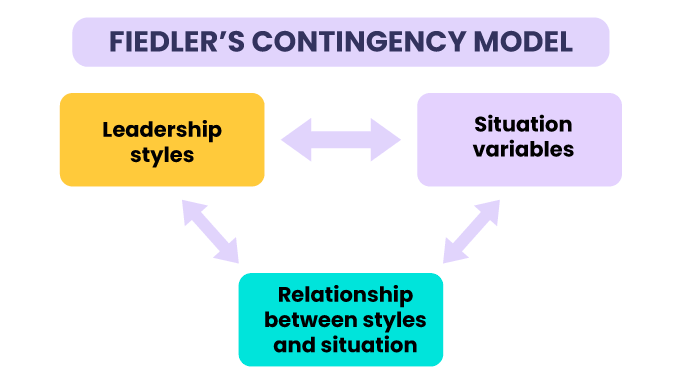
CONTINGENCY THEORY (Fred Fiedler)
Fred Fiedler’s contingency theory suggests that there is no one-size-fits-all approach to management. Instead, the most effective management style depends on the specific situation.
Fiedler proposed that the effectiveness of a leader depends on the match between their leadership style and the favorableness of the situation, which is determined by factors such as task structure, leader-member relations, and position power.
This theory emphasizes the need for leaders to adapt their management style based on the circumstances and the characteristics of their team members.
Principles of Contingency Theory
- Leadership Style: Fiedler’s Contingency Theory states that there is not one best style of leadership. Instead, the most effective leadership style for any given situation is one that aligns with the situation at hand, therefore, Rejects the idea of a universal management style.
- Least Preferred Coworker (LPC) Scale: Fiedler developed the LPC scale to measure an individual’s leadership orientation. A high LPC score suggests a “human relations orientation,” while a low LPC score indicates a “task orientation” .
- Situational Favorability: Fiedler’s theory emphasizes the importance of situational control for a leader’s effectiveness. Situational favorability is determined by task structure, leader-member relations, and position power in determining the appropriate management approach.
Advantages and Disadvantages to the Organization:
Advantages:
- Flexibility: Contingency Theory allows organizations to adapt their leadership style to different situations, increasing the chances of success.
- Improved Performance: By matching leadership style to the situation, organizations can enhance performance and achieve better outcomes.
- Effective Decision Making: Contingency Theory helps leaders make informed decisions based on the specific circumstances they are facing.
Disadvantages:
- Complexity: Implementing Contingency Theory requires a deep understanding of various situational factors, which can be complex and challenging to assess accurately.
- Lack of Consistency: The theory suggests that there is no one-size-fits-all approach to leadership, which can lead to inconsistency in leadership practices within an organization.
- Reliance on Leader’s Assessment: The effectiveness of Contingency Theory relies on the leader’s ability to accurately assess the situation and adjust their leadership style accordingly.
Advantages and Disadvantages to the Employee:
Advantages:
- Increased Job Satisfaction: When leaders adapt their style to match the situation, employees may experience higher job satisfaction due to better communication and support.
- Improved Motivation: Employees are more likely to be motivated when they perceive their leader as understanding and responsive to their needs.
- Enhanced Performance: Employees may perform better when their leader’s style aligns with the demands of the situation, leading to improved productivity and outcomes.
Disadvantages:
- Inconsistency: Employees may find it challenging to adapt to different leadership styles depending on the situation, leading to confusion and uncertainty.
- Lack of Autonomy: In situations where leaders have high control and influence, employees may feel restricted in their decision-making and autonomy.
- Potential for Bias: The effectiveness of Contingency Theory relies on the leader’s assessment of the situation, which may introduce bias and subjective judgments.
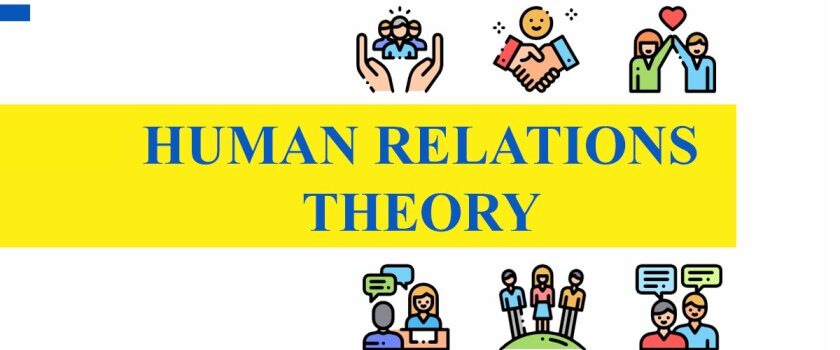
HUMAN RELATION THEORY (Elton Mayo)
The Human Relations Theory, developed by Elton Mayo, emphasizes the importance of social relationships and group dynamics in the workplace. Mayo’s research, particularly the Hawthorne studies, highlighted the impact of social factors on employee productivity and motivation.
Human relation theory concentrates on the impact of individuals on an organization’s success or failure. Instead of solely focusing on the organization’s structure, managers encourage the development of employees’ potential and help them meet their needs for recognition, accomplishment, and a sense of belonging.
Mary Parker Follett, an influential figure in this theory, stressed the importance of coordinating the psychological and sociological aspects of management. She believed that management is a social process and emphasized the importance of situational factors in decision-making and the concept of “power with” rather than “power over” others.
- In this theory, the focus is on the empowerment of the individual worker as a source of control, motivation, and productivity in the organizations.
- The Hawthorne studies led to the belief that human relation between workers and managers and among the workers were the main determinants of efficiency.
- The Hawthorne effect refers to the phenomenon of how being observed or studied results in a change of behavior.
- This theory also emphasizes participatory decision making which increases worker’s autonomy.
- It also lays emphasis on the training of the employees to improve work.
Principles of the Human Relations Theory
- Social Interaction: Mayo believed that employees are motivated by social interactions and relationships within the workplace. Positive social bonds and a supportive work environment can enhance employee satisfaction and productivity.
- Individual Attention: Recognizing employees as individuals with unique needs and aspirations is crucial. Providing individual attention and support can foster a sense of significance and belonging, leading to increased motivation and productivity.
- Participation and Involvement: Mayo advocated for involving employees in decision-making processes and giving them a voice in matters that affect their work. This participation can enhance employee engagement and commitment to the organization.
- Informal Communication: Mayo emphasized the importance of informal communication channels, such as conversations and interactions among employees. These informal networks can facilitate the exchange of ideas, build relationships, and create a positive work environment.
- Leadership Style: Mayo believed that leaders should adopt a supportive and participative leadership style. Leaders should focus on building relationships, providing guidance, and creating a supportive work environment.
Advantages and Disadvantages to the Organization:
Advantages:
- Increased employee satisfaction and motivation.
- Improved teamwork and collaboration.
- Enhanced employee engagement and commitment.
- Enhanced organizational culture and cohesion.
- Higher productivity and efficiency.
- Reduced turnover and absenteeism.
- Better retention of talented employees.
Disadvantages:
- Potential resistance to change from employees accustomed to traditional management approaches.
- Time-consuming process of building and maintaining positive social relationships.
- Potential for decreased focus on productivity.
- Possibility of conflicts arising from social dynamics.
- Challenges in maintaining a balance between social needs and work objectives.
- Resistance to change due to strong social bonds.
- Difficulty in quantifying the impact of social factors on productivity.
Advantages and Disadvantages to the Employee:
Advantages:
- Increased job satisfaction and sense of belonging.
- Opportunities for personal and professional growth.
- Supportive work environment.
- Enhanced communication and collaboration with colleagues.
- Greater involvement in decision-making processes.
- Recognition and appreciation for individual contributions.
Disadvantages:
- Potential conflicts and disagreements within the workplace.
- Pressure to conform to group norms and expectations.
- Limited individual autonomy in decision-making.
- Potential for favoritism or bias in social relationships.
- Possibility of blurred boundaries between work and personal life.
- Increased workload due to informal expectations.
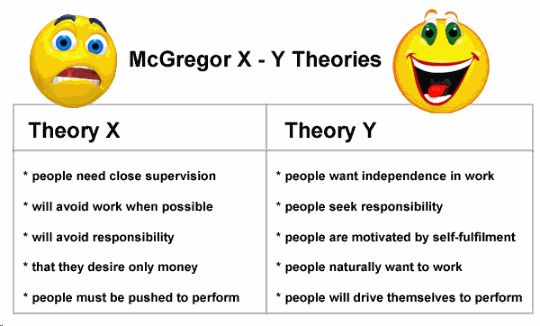
BEHAVIORAL SCIENCE THEORY(Douglas McGregor)
The behavioral management theory is often called the human relations movement because it addresses the human dimension of work. Maslow’s Hierarchy of needs also lies under behavioral science theory.
Theory X assumes that employees dislike work and must be directed and controlled, while Theory Y suggests that employees can find satisfaction in their work and are self-motivated.
Douglas McGregor expressed his views of human nature in two sets of assumptions. They are popularly known as ‘Theory X’ and ‘Theory Y’
Theory X assumptions: Theory X reflects a common attitude among managers that most people do not want to work very hard and that the manager’s job is to make sure that they do work hard. To accomplish this, according to Theory X, a manager needs to employ strict rules, constant supervision, and the threat of punishment (reprimands, withheld raises, and threats of job loss) to create industrious, motivated workers.
- Employees inherently dislike work and, whenever possible, will attempt to avoid it.
- Since employees dislike work, they must be coerced, controlled, or threatened with punishment.
- Employees will avoid responsibilities and seek formal direction whenever possible.
- Most workers place security above all other factors and will display little ambition.
Managers who believe on the assumption of Theory X will always do the following;
- He/she will always do the thinking and planning with little input from staff.
- He/she will always motivate workers through fears and threats.
- He/she will be failing to make use of workers’ potential.
- They will delegate little but supervise closely.
Theory X:
Advantages to Organizations | Disadvantages to Organizations |
– Clear hierarchy and control structure | – Creates a negative work environment |
– Provides a structured approach to management | – Decreases employee morale and motivation |
– Ensures tasks are completed as directed | – Limits creativity and innovation |
– Can be effective in managing routine tasks | – May lead to high turnover rates |
– Managers have greater control over employees | – Increases resistance to change |
Advantages to Employees | Disadvantages to Employees |
– Provides clear expectations and guidelines | – Reduces autonomy and freedom |
– Offers security through consistent supervision | – Limits opportunities for personal growth |
– Offers stability in job roles and tasks | – Can lead to job dissatisfaction |
– Provides direction and structure | – Increases stress and job-related tension |
– May offer opportunities for skill development | – Decreases job satisfaction and morale |
Theory Y assumptions: Theory Y managers believe that the work itself can be motivating and that people will work hard if their managers provide a supportive environment. A Theory Y manager emphasizes guidance rather than control, development rather than close supervision, and reward rather than punishment. A Theory Y nurse manager is concerned with keeping employee morale as high as possible, assuming that satisfied, and motivated employees will do the best work
- Employees can view work as being as natural as rest or play.
- People will exercise self-direction and self control if they are committed to the objectives.
- The average person can learn to accept, even seek, responsibility.
- The ability to make innovative decisions is widely dispersed throughout the population.
Managers who before in Theory Y will always do the following;
- They will always delegate where necessary.
- Will allow participation in work by all employees.
- Will give general supervision than close supervision
- Normally motivates employees by praises and recognition.
Theory X:
Advantages to Organizations | Disadvantages to Organizations |
– Fosters a positive work culture and environment | – May result in decreased control over employees |
– Encourages creativity and innovation | – Can be challenging to implement in certain industries or contexts |
– Increases employee motivation and satisfaction | – Requires a higher level of trust in employees |
– Leads to higher levels of employee engagement | – May result in slower decision-making processes |
– Promotes adaptability and flexibility | – Potential for conflicts between management and employees |
Advantages to Employees | Disadvantages to Employees |
– Offers opportunities for autonomy and self-direction | – May increase stress due to higher levels of responsibility |
– Promotes personal and professional growth | – Requires a higher level of self-motivation |
– Recognizes and values employee contributions | – Can lead to increased workload |
– Provides opportunities for skill development | – Increases pressure to perform |
– Fosters a positive work-life balance | – Requires a higher level of accountability |
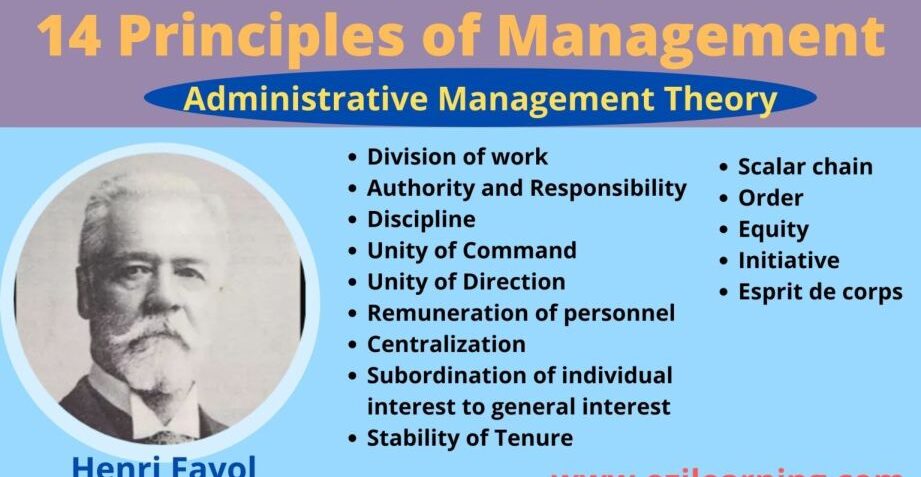
ADMINISTRATIVE THEORY(Henri Fayol)
Administrative theory is the oldest theory and is sometimes referred to as traditional management theory. It considers the organization as a whole, rather than solely focusing on production.
Henri Fayol, a prominent contributor to this theory, identified the functions of managers and concluded that management is universal. He advocated for specialization, equal treatment, stability of personnel, and the teaching of management in colleges.
Henri Fayol’s administrative theory focuses on the principles of management that can be applied universally to any organization or industry.
- Fayol identified five key functions of management: planning, organizing, commanding, coordinating, and controlling. He also outlined 14 principles of management, including unity of command, division of work, and scalar chain.
Importance of Administrative theory
- It makes organization to be viewed as a whole rather than focusing solely on production.
- It gives the view of control, authority, responsibility and accountability.
- He studied the functions of managers and concluded that management is universal. He believed that;
- All managers have the responsibilities of planning, organizing, issuing orders, coordinating, and controlling.
- He derived general principles of administration from his observations.
- He believed in the division of work.
- He argued that specialization increases efficiency.
- Advocated that there is a place for everything and everything in its place.
- He developed group harmony through equal treatment and stability of tenure of personnel.
- He also urged that management be taught in colleges.

PRINCIPLES OF MANAGEMENT
Henri Fayol, a renowned French mining engineer, developed a set of principles known as the Principles of Administrative Theory.
Principles of management are the means by which one actually manages, that is, gets things done through others—individually, in groups, or in organizations.
Fayol has given 14 principles of management with the intent to improve the functioning of the managers.
- Division of Work: The work should be divided among the individuals on the basis of their specializations, so as to ensure their full focus on the effective completion of the task assigned to them.
- Authority and Responsibility: The authority and responsibility are related to each other. Authority means the right to give orders while responsibility means being accountable. Thus, to whomsoever the authority is given to exact obedience must be held accountable for anything that goes wrong.
- Discipline: The individuals working in the organization must be well disciplined. The discipline refers to the obedience, behavior, and respect shown by the employees towards others.
- Unity of Command: According to this principle, an individual in the organization must receive orders from only one supervisor. In case an individual has the reporting relationship with more than one supervisor then there may be more conflicts with respect to whose instructions to be followed.
- Unity of Direction: Unity of direction means, all the individuals or groups performing different kinds of a task must be directed towards the common objective of the organization.
- Subordination of Individual to General Interest: According to this principle, the individual and organizational interest must coincide to get the task accomplished. The individual must not place his personal interest over the common interest, in case there is a conflict.
- Remuneration of Personnel: The payment methods should be fair enough such that both the employees and the employers are satisfied.
- Centralization: Fayol defines centralization as the means of reducing the importance of a subordinate’s role in the organization, and the extent to which the authority is centralized or decentralized depends on the organization type in which the manager is working.
- Scalar Chain of Command: This means there should be a proper hierarchy in the organization that facilitates the proper flow of authority and communication. It suggests that each individual must know from whom he shall get instructions and to whom he is accountable to. Also, the communication either going up or down must pass through each level of authority. In certain circumstances where the quick flow of communication is required, the rigidity of a scalar chain can pose problems. Thus, Henry Fayol has suggested “gang plank” which means anybody in the hierarchy can interact with each other irrespective of their authority levels.
- Order: This principle is related to the systematic arrangement of things and people in the organization. This means every material should be in its place, and there should be a place for every material. Likewise, in the case of people, a right man should be in the right job.
- Equity: All the employees in the organization must be treated equally with respect to justice and kindliness.
- Stability of Tenure: The employees should be retained in the organization, as new appointments may incur huge selection and training cost.
- Initiative: The manager must motivate his subordinates to think and take actions to execute the plan. They must be encouraged to take initiatives as this increases the zeal and energy among the individuals.
- Esprit de Corps: This means “unity is strength”. Thus, every individual must work together to gain synergy and establish cordial relations with each other.
Advantages and Disadvantages to the Organization:
Advantages:
- Improved efficiency and productivity.
- Clear chain of command and communication.
- Enhanced coordination and unity among employees.
- Effective utilization of resources.
- Motivated and loyal workforce.
- Provides a universal framework for management.
Disadvantages:
- Potential for excessive centralization and lack of employee empowerment.
- Rigidity in decision-making and resistance to change.
- Possibility of creating a hierarchical and bureaucratic organizational culture.
- Limited flexibility in adapting to unique environments.
- Challenges in maintaining unity of command.
Advantages and Disadvantages to the Employee:
Advantages:
- Clear structure and hierarchy.
- Clear understanding of roles and responsibilities.
- Fair compensation and recognition for their work.
- Job security and stability.
- Opportunities for growth and development.
- Sense of belonging and team spirit.
Disadvantages:
- Limited autonomy and decision-making power.
- Potential for lack of creativity and innovation.
- Possibility of feeling constrained by strict rules and regulations.
- Potential for conflicts arising from a hierarchical structure.
- Possibility of slower response to change.
- Potential for micromanagement.

Importances of management
The aim of all managers is the same regardless of rank and type organization – to increase productivity. This means effectiveness and efficiency that is achieving organizational goals and achieving them at low cost. Effective management therefore is the concern of a corporation president, a medical superintendent, a commissioner in the ministry, a church Bishop, a school head prefect, and others.
- Achievement of Organizational Goals: Effective management ensures that organizations are able to set and achieve their goals. Managers develop strategic plans, define objectives, allocate resources, and coordinate efforts to ensure that the organization’s objectives are met.
- Efficient Resource Utilization: Management helps in optimizing the use of available resources such as human capital, financial assets, and technological resources. By effectively allocating resources and avoiding wastage, management enhances productivity and reduces costs.
- Decision Making: Managers are responsible for making important decisions that impact the organization. Through their expertise and experience, managers analyze information, evaluate alternatives, and make informed decisions to address challenges and capitalize on opportunities.
- Motivation and Employee Engagement: Effective management creates a positive work environment and motivates employees to perform at their best. Managers inspire and empower their teams, provide guidance and support, recognize achievements, and foster a culture of collaboration and innovation.
- Conflict Resolution: Conflicts and disagreements are inevitable in any organization. Skilled managers are equipped with conflict resolution techniques and can mediate disputes, promote understanding, and maintain harmonious relationships among team members.
- Adaptability and Change Management: In a dynamic business environment, adaptability is crucial. Managers play a key role in identifying changes, formulating strategies to respond to them, and guiding the organization through transitions effectively.
- Enhancing Communication and Coordination: Effective management facilitates communication and coordination among different levels and departments within an organization. Clear communication channels, efficient information sharing, and collaborative efforts are vital for organizational success.
- Risk Management: Managers assess and manage risks that an organization may face. They identify potential risks, develop contingency plans, and implement risk mitigation strategies to protect the organization’s interests.
- Continuous Improvement: Management encourages a culture of continuous improvement by promoting innovation, conducting performance evaluations, and implementing feedback mechanisms. This helps organizations stay competitive and adapt to evolving market conditions.


I love this, thank you.
Guiding questions
Very educative